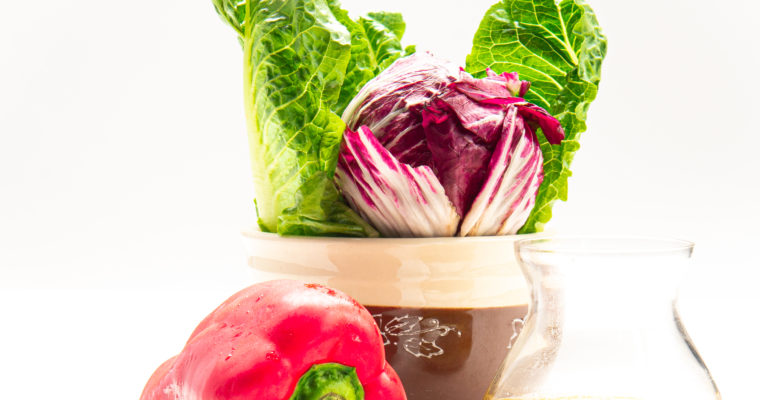There I was, like a jilted bride ditched at the altar, clutching a huge bouquet of leafy emerald green sweet basil and wondering what the heck to do next.
Believe me, I had no plans for any major cooking projects using basil when I drove down PCH to the Long Beach Farmers Market this week. It just happened. Like a proposal from a feckless suitor, the huge bunches of exquisitely aromatic basil on the vendors’ tables beckoned and I was in a mood to say yes.
Since these lazy late summer days are salad days at my house anyway, I decided to try David Lebovitz’ basil vinaigrette recipe–a riff on pesto sans the pine nuts. I had just bought some glorious Spanish olive oil from the Antica Olive Oil store in Los Alamitos, so the marriage of my beautiful basil and my extraordinary olive oil seemed perfect.
The truth is that I’ve been working on my vinaigrette game this summer–looking for that certain something that turns an uninspired oil and vinegar vinaigrette into something special. I want it to be pretty, too. This simple vinaigrette recipe seemed like it might be the one.
Fresh basil is a very interesting ingredient. It has graced people’s dinner tables for a very long time.
Basil is believed to have originated in Africa. It has been cultivated in India for over 5000 years and was known to Greek and Roman cooks. In more modern times, the French and the Italians took basil purees, pistous and pestos, to culinary heights.
According to Harold McGee’s On Food and Cooking, basil was relatively unknown here in the United States until the 1970s. How is that even possible? I guess American cooks were busy turning out tuna casseroles and jello molds. Ugh.
I’m not doubting McGee, though. He is a culinary giant. A Yale PhD (in romantic poetry!), he writes about food chemistry and history and has authored a number of important books including On Food and Cooking which was first published thirty-two years ago and was revised and updated in 2004. His book is seen by many as the book that pioneered the kitchen science book genre where technical food science is translated into engaging reader-friendly prose.
McGee also has written for The New York Times, Food and Wine Magazine and Physics Today and is a sought-after lecturer/teacher in venues as varied as The French Culinary Institute in New York City and the Fermi National Accelerator Laboratory. (No.The Fermi reference is not a typo.)
Since 2010, he has been a visiting lecturer at Harvard, teaching their course “Science and Cooking: From Haute Cuisine to Soft Matter Science.” Talk about a Renaissance man!
Back to basil. Basil is in the mint family and is related to culinary herbs ranging from lavender to marjoram to oregano to sage and thyme.
Heaven knows I’ve tried to grow my own basil. McGee’s book calls basil a “hardy” annual. Not for me.
I keep buying those pots of basil at Trader Joe’s and convincing myself that I won’t kill yet another one. Einstein was right, of course: “Insanity: doing the same thing over and over again and expecting different results.” So it is with me and growing basil.
Interestingly, McGee writes that the delicious aroma of the sweet basil leaf varies greatly depending upon the age of the plant. “The flavor of basil depends not only on the variety, but on growing conditions and the stage at which it is harvested. Generally, aroma compounds make up a larger proportion of young sweet basil leaves than old, by as much as five times. In leaves that are still growing, the relative proportions of the different compounds actually vary along the length of the leaf, with the older tip richer in tarragon and clove notes, the younger base in eucalyptus and floral notes.”
I can see this vinaigrette being drizzled over any number of cold vegetables. Today I enjoyed it over cold roasted beets.
Lebovitz describes drizzling it over white beans. That sounds good, too.
Maybe I’ll do that for dinner.
Ingredients: Basil Vinaigrette
1/2 C. extra-virgin olive oil
1 1/2 T. red or white wine vinegar (I used a white balsamic)
1 T. water
1 small shallot (peeled and sliced)
1 t. Dijon mustard
3/4 t. kosher salt
2 C. loosely-packed fresh basil leaves
Directions:
Combine olive oil, vinegar, water, shallot, mustard and salt in a blender. Add coarsely chopped basil leaves. Blend, scraping down sides of blender jar, until you have a smooth sauce. This will take about 15 to 30 seconds. This vinaigrette can be thinned with a bit more water or olive oil.


